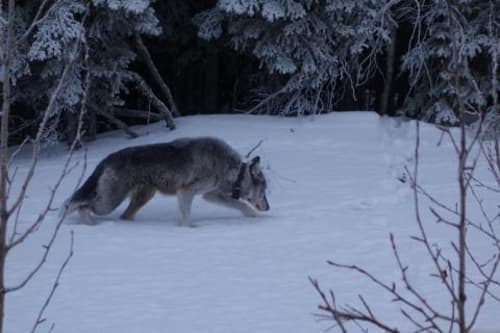
TOOLIK FIELD STATION — After 800-plus miles by snowmachine and three weeks of working in the same clothes, it’s time to pack our duffel bags, stuff them into a barrel and set them on fire.
Just kidding about the burn barrel, but three lake studiers and I returned last night to the slushy snow of Toolik Lake, where I got my machine stuck 50 yards from the sauna. There, the boys unrolled the tow ropes and rescued me one last time.
Thanks for that to Ben Jones of the US Geological Survey Science Center in Anchorage, who invited me on this arctic adventure, Guido Grosse of the Alfred Wegener Institute in Germany and Chris Arp of the University of Alaska Fairbanks’ Water and Environmental Research Center.
We seem to have broken the back of winter — the four of us left this research camp in a biting wind and returned to newly emerged ground squirrels playing grab-tail. There are also many more humans here at Toolik now, including squirrel studiers from UAF and a nature documentary crew from the British Broadcasting Company.
We are drying wet things in brilliant sunshine and enjoying a day of decompression. It’s nice to ease off trip mode with the friendly staff here, who are dressed like us, unshaven like us and, after our recent reintroduction to hot water, more overdue for a shower.
Before I exit this blue-white world and drive over Atigun Pass into a different universe, here are some impressions of 21 days north of the Arctic Circle with three guys I barely knew.
* First, the science: the guys gathered hundreds of measurements, filled dozens of tiny bottles with lake water and have tubes of frozen earth and peat ready to ship back to Germany. They have a lot of data to chew on. Three years into their four-year study, they saw the hint of a trend: more snow and thinner ice on the northernmost lakes on our route. This change may be related to the shrinking pack of sea ice on the northern ocean.
More about my traveling/living companions: Ben Jones is a born leader afraid of no mechanical challenge. His interest in everything from burned tundra to fly larvae clinging to rocks leads to what some scientists call “scope creep.” This can be a negative when trying to focus on one thing, but those creative diversions often result in great things. He is a horse that needs to run free.
Guido Grosse celebrated his 38th birthday with us at Ben Jones Camp on Teshekpuk Lake. He looks ten years younger. The tall, kind German always appeared with a boyish smile when someone yelled “Guido, bring the thunder!” He would then proceed to grab a 700-pound sled by its plastic tongue and pull it toward a hitch, sling a 70-pound Arctic Oven tent over his shoulder or open a jar of olives.
Chris has the nasal cadence and snappy timing of a stand-up comedian. I admired the way he jousted with other team members in order to execute the science the way he saw proper. He always woke up first and got the rest of us going. Chris never asked me to do anything, but always thanked me when I did.
All the guys were pros, staying up with the now-endless arctic daylight to finish drilling lakes and tundra, often not tying up the sleds until 10 p.m.
Sometimes, when I was tired and helping shove a blatting two-cycle drill into frozen soil, their zeal made me cranky. But most of the time I liked helping, even though I was the least efficient data gatherer.
Pages: 1 2








